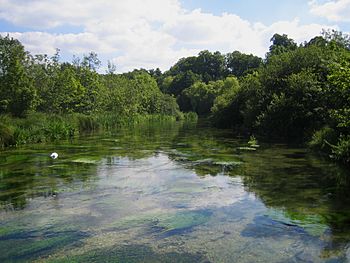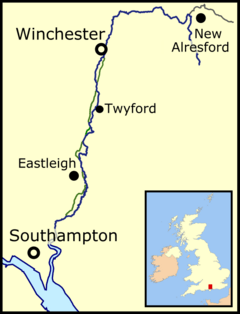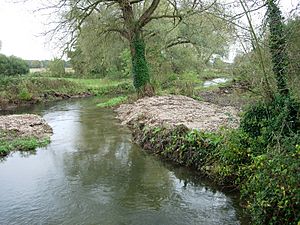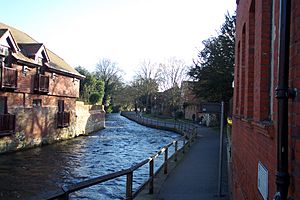River Itchen, Hampshire facts for kids
Quick facts for kids Itchen |
|
|---|---|

The Itchen near Avington
|
|

Map of the River Itchen (dark blue) and its principal tributary (the Alre, grey). Southampton Water is shown in light blue and canal sections of the Itchen Navigation in green.
|
|
| Other name(s) | Alre (see tributary so-named) |
| Country | England |
| County | Hampshire |
| City | Winchester Southampton |
| Physical characteristics | |
| Main source | south of New Cheriton, Kilmeston, Hampshire, England 51°02′33″N 1°09′37″W / 51.0426°N 1.1603°W |
| River mouth | Southampton Water Southampton, Hampshire 0 metres 50°54′19″N 1°23′08″W / 50.9052°N 1.38565°W |
| Length | 26 miles (42 km) or unconventionally: 88 km (55 mi) (including all anabranches) |
| Width |
|
| Discharge (location 2) |
|
| Discharge (location 3) |
|
| Basin features | |
| Basin size | 119.619 km2 (46.185 sq mi) |
| Tributaries |
|
| Site of Special Scientific Interest | |

The river near Bishopstoke
|
|
| Area of Search | Hampshire |
|---|---|
| Interest | Biological |
| Area | 748.5 hectares (1,850 acres) |
| Notification | 2000 |
| Location map | Magic Map |
The River Itchen is a special kind of river called a chalk stream. It flows through Hampshire in southeast England. The river starts south of New Alresford and travels about 26 miles (42 km) (42 km). It eventually joins Southampton Water near the Itchen Bridge.
Long ago, in the late 1600s and early 1700s, people built the Itchen Navigation. This was a way for barges (flat-bottomed boats) to carry goods. They could travel from Southampton Docks all the way to Winchester. However, this navigation stopped being used in the mid-1800s. Today, much of it is no longer used.
The River Itchen is famous for fly fishing. It's known as one of the best chalk streams in the world for this sport. The river's clear water comes from underground chalk layers. These layers naturally filter the water, making it very clean. This is why the river has been used for drinking water for a long time. You can also find lots of Watercress growing in the upper parts of the river.
A large part of the river, from where it starts to Swaythling, is a protected area. It's called a Site of Special Scientific Interest (SSSI) and a Special Area of Conservation. This means it's important for its wildlife and nature. Part of this area is the Hockley Meadows nature reserve. The Itchen estuary, where the river meets the sea, is also a separate SSSI.
Contents
What's in a Name?
The name "Itchen" probably comes from an old Brittonic language. We don't know exactly what it means. In old records, like the Domesday Book from 1086, the village of Itchen Abbas was written as "Icene." The letter 'c' followed by 'e' or 'i' was used to make a certain sound back then. Sometimes, the upper parts of the Itchen were even called the Alre, which is now a tributary.
Where Does the River Flow?
The River Itchen begins north of Kilmeston village. It first flows north through Cheriton village. Then it passes east of Tichborne village, which is mostly farmland.
Joining Other Streams
The Itchen meets two other streams, the River Alre and Candover Brook. This happens just northwest of New Alresford. After this, the river turns west. It flows past villages like Avington, Itchen Stoke, Itchen Abbas, Martyr Worthy, Easton, and Abbots Worthy.
Through Winchester City
The river then enters the historic city of Winchester. It crosses Winnall Moors and turns south for the rest of its journey. In Winchester, the river splits into several smaller channels called anabranches. Some of these flow very close to Winchester Cathedral. In the past, this caused problems for the cathedral's foundations.
The main channel of the river goes through Winchester City Mill. It also flows east of the city's old Roman walls. This part of the river is known as "The Weirs" and has a nice walkway beside it.

Journey to the Sea
The river flows through water-meadows, which are fields that can sometimes flood. It passes by the Hospital of St Cross and the villages of Twyford and Shawford. It also flows between the town of Eastleigh and the village of Bishopstoke.
Next, it goes through Itchen Valley Country Park. Finally, it reaches the northern parts of Southampton at Mansbridge. Between Winchester and Mansbridge, parts of the river were made deeper or wider. This was for the old Itchen Navigation, which is no longer used. The path next to the river, called the towpath, is now part of the Itchen Way walking route.
Monks Brook flows into the Itchen at Swaythling. After this, the river goes under Woodmill Bridge and becomes tidal. This means its water level changes with the ocean tides.
Important Bridges
Before the Itchen meets the Test estuary in Southampton Water, four more bridges cross it:
- Cobden Bridge: This is a road bridge connecting Bitterne Park and St Denys.
- Cobden railway bridge: This bridge carries the railway line between Southampton and Portsmouth. It opened in 1866.
- Northam Bridge: This road bridge carries the A3024 road. It connects Bitterne Manor to Northam and first opened in 1799.
- Itchen Bridge: This is a tall toll road bridge. It connects the docks area with Woolston. It replaced an old chain ferry called the Woolston Floating Bridge.
Between the Northam Bridge and the Itchen Bridge, the river passes St Mary's Stadium. This is the home stadium for the Southampton F.C. football team. As the river reaches Southampton Water, you can see several rowing and sailing clubs. There's also a big new development on the left bank in Woolston called Centenary Quay.
Watermills on the Itchen
Many old watermills once used the power of the River Itchen. Some still exist today:
- Winchester City Mill: This mill has been repaired by the National Trust and can grind flour again.
- Abbey Mill: This mill has been turned into a restaurant.
- St Cross Mill
- Gaters Mill: This mill is now used as offices.
- Woodmill: Located in Southampton, this is now a center for water activities.
Marinas and Boatyards
The lower part of the River Itchen is a busy place for boats. It has many marinas (places to dock boats), sailing centers, and boatyards (places to build or repair boats).
Here are some of the main ones, starting from the sea:
- Ocean Village Marina: This is on the western side, just below the Itchen Bridge.
- Southampton Water Activities Centre: Almost directly under the Itchen Bridge.
- Itchen Marine: Just above the bridge, this business mainly helps tow boats.
- Merlin Boatyard: This is on the eastern side of the river.
- Lauren Marine Services: A smaller marina on the eastern side.
- Ocean Quay and Solent Breeze Yacht Charter: Both on the west side.
- Shamrock Quay: This is the largest marina on the river, also on the west side.
- Saxon Wharf: Next to Shamrock Quay, it has a very large boat lift.
- Kemps Quay Marina: On the eastern side, this marina dries out at low tide.
- Quayside Marina: A long dock next to Kemps.
- Drivers Wharf: Another long dock with a crane and boatyard.
Above Northam Bridge, large boats with masts cannot go any further. In this area, you'll find the Vespasian Road boatyard and many smaller boat businesses.
Wildlife in the River
The protected SSSI area includes the river and its banks. It has different habitats like fen (wetlands), flood meadows, wet woodlands, and swamps. These areas are home to many interesting animals.
Rare Creatures
The River Itchen is home to some rare species:
- The southern damselfly: A type of insect similar to a dragonfly.
- The white-clawed crayfish: A freshwater creature similar to a small lobster.
Other Animals
You can also find other amazing wildlife here:
- Otters: Playful mammals that live in and around the water.
- Water voles: Small rodents that live near rivers.
- Atlantic salmon: Fish that swim upriver to lay their eggs.
- Shovelers: A type of duck with a large, shovel-shaped bill.
- Cetti's warblers: Small birds known for their loud songs.
Water Quality
The Environment Agency checks the water quality of rivers in England. They give each river an "ecological status" (how healthy the environment is). This can be high, good, moderate, poor, or bad. They also check the "chemical status" (how clean the water is from pollution), which is either good or fail.
Here's how parts of the River Itchen were rated in 2019:
| Section | Ecological Status |
Chemical Status |
Overall Status |
|---|---|---|---|
| Itchen | Good | Fail | Moderate |
| Itchen (Cheriton Stream) | Good | Fail | Moderate |
| Candover Brook | Moderate | Fail | Moderate |
| Nun's Walk Stream | Good | Fail | Moderate |
Even though some parts of the river have a good ecological status, the chemical status for all sections was "fail" in 2019. This means there were too many chemicals in the water.
Images for kids



